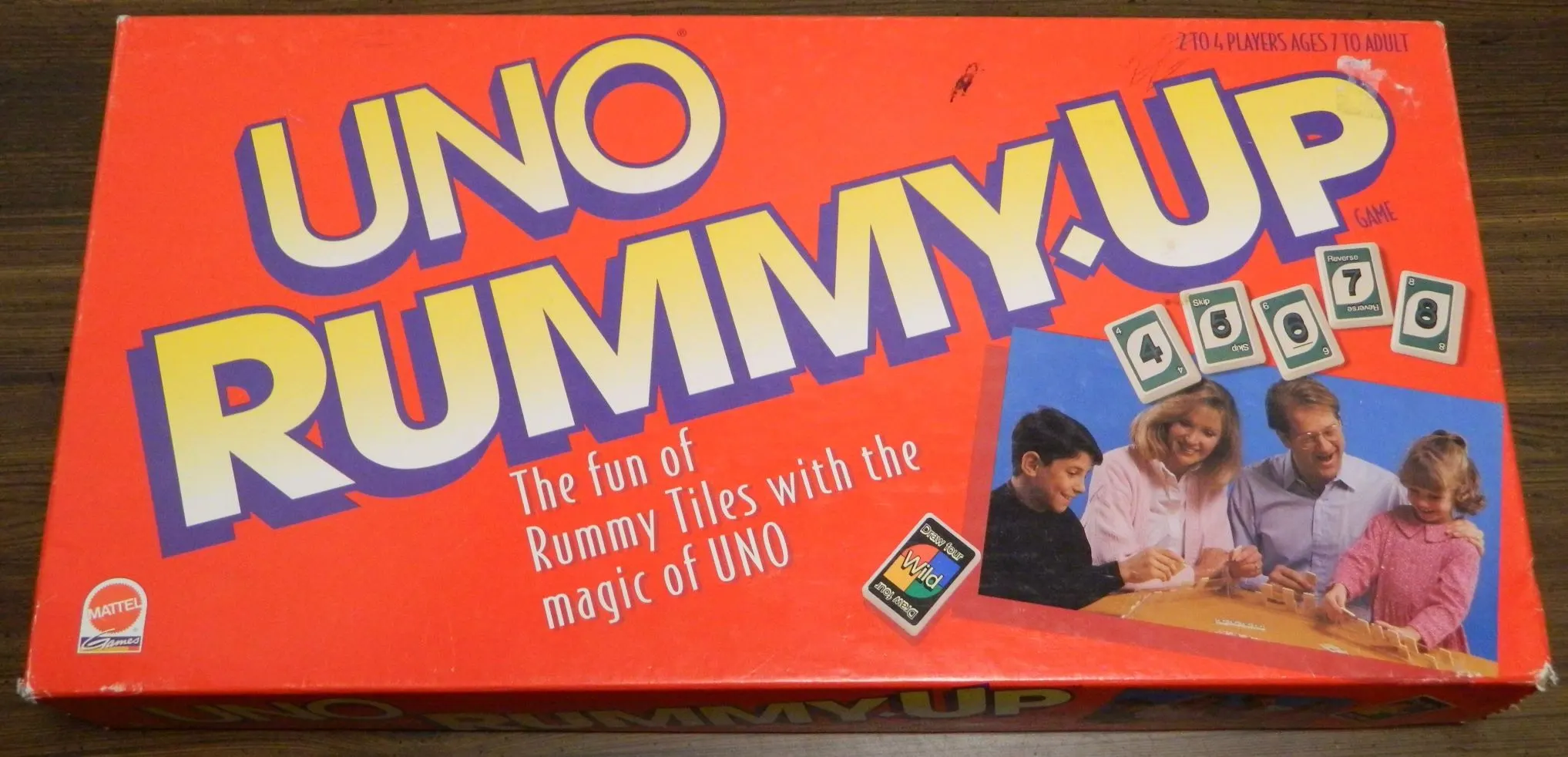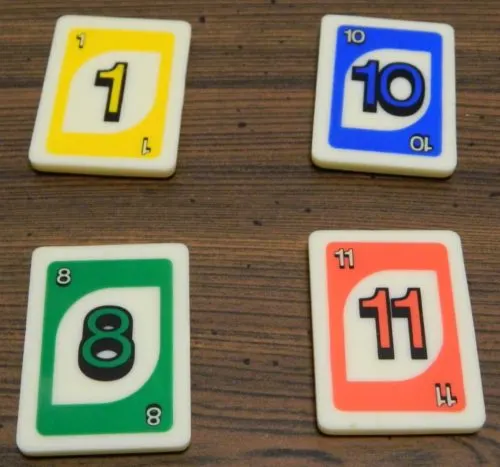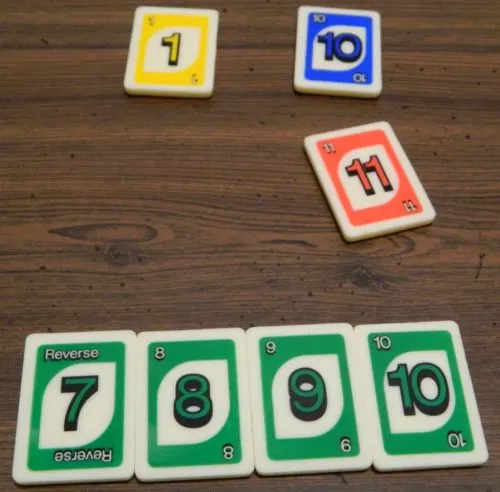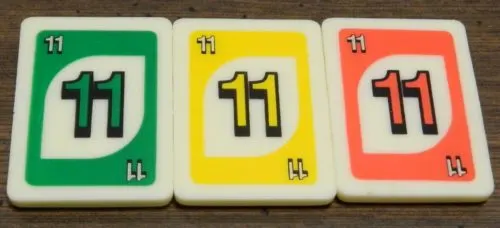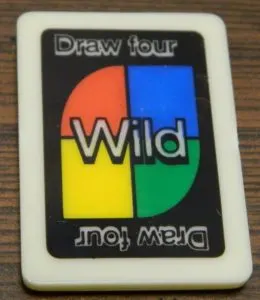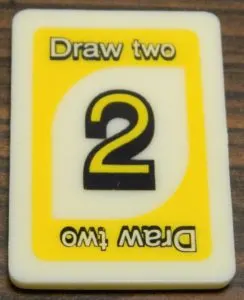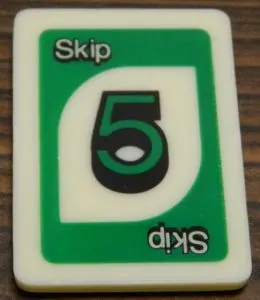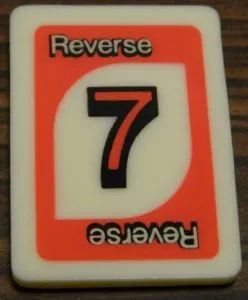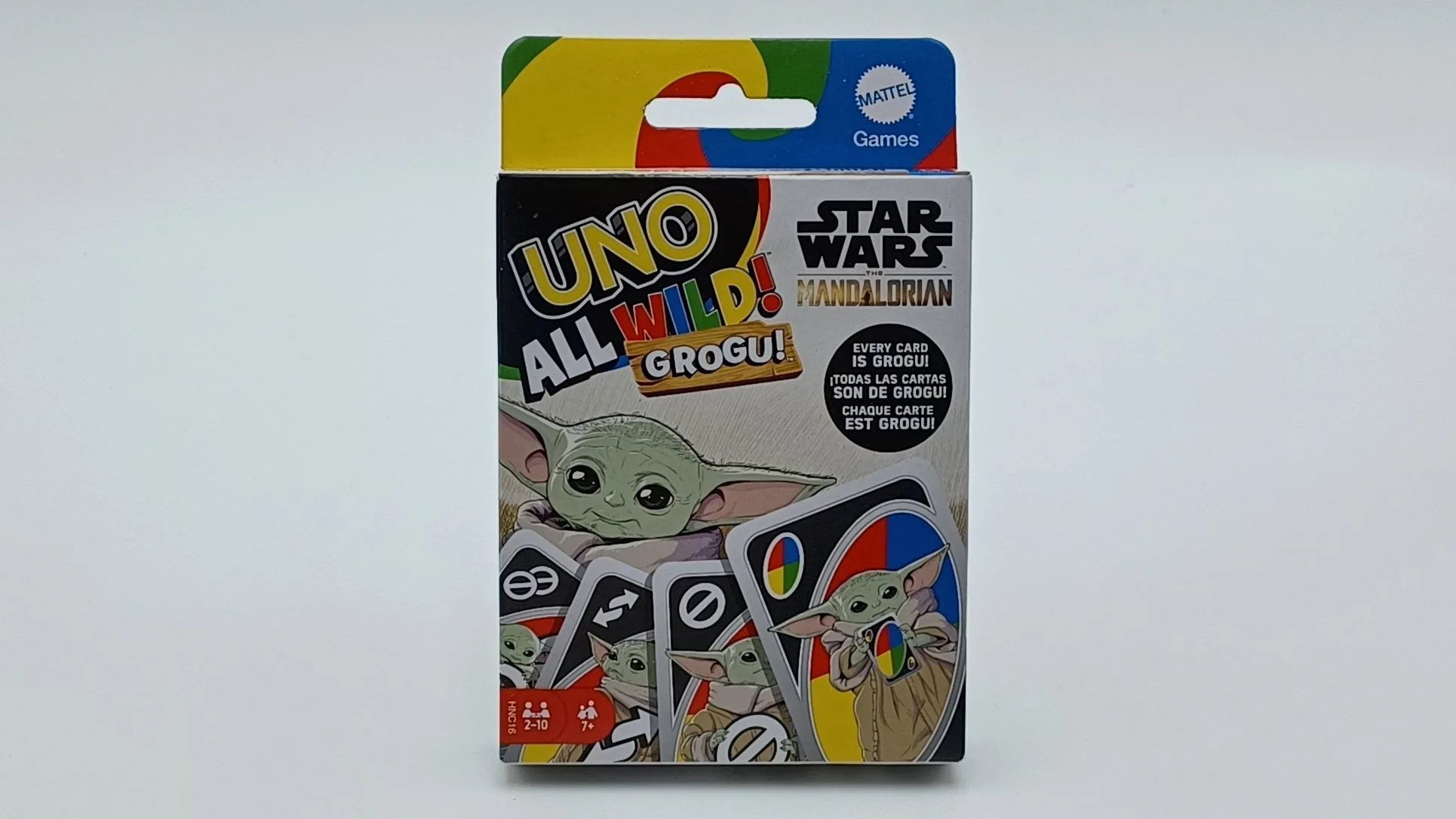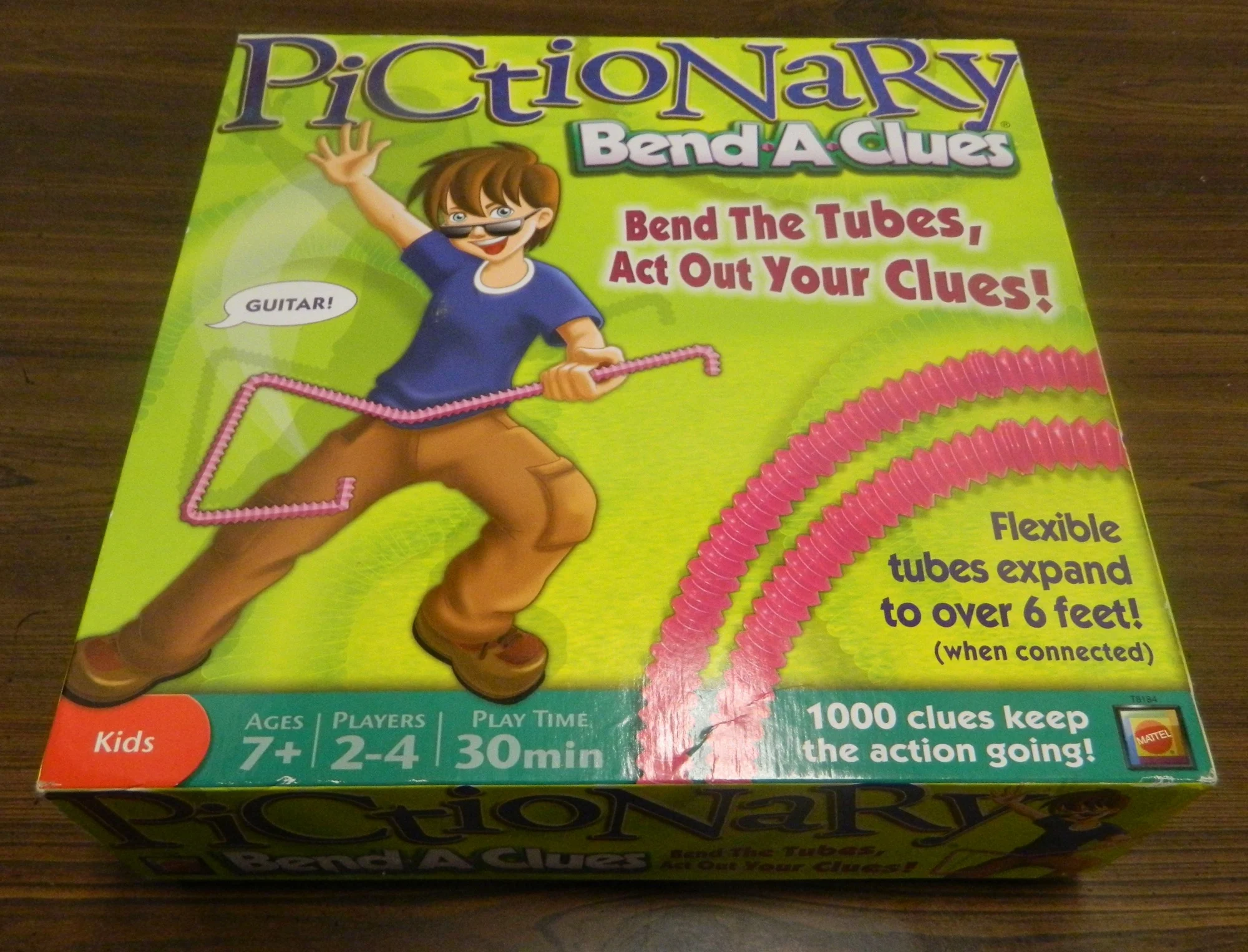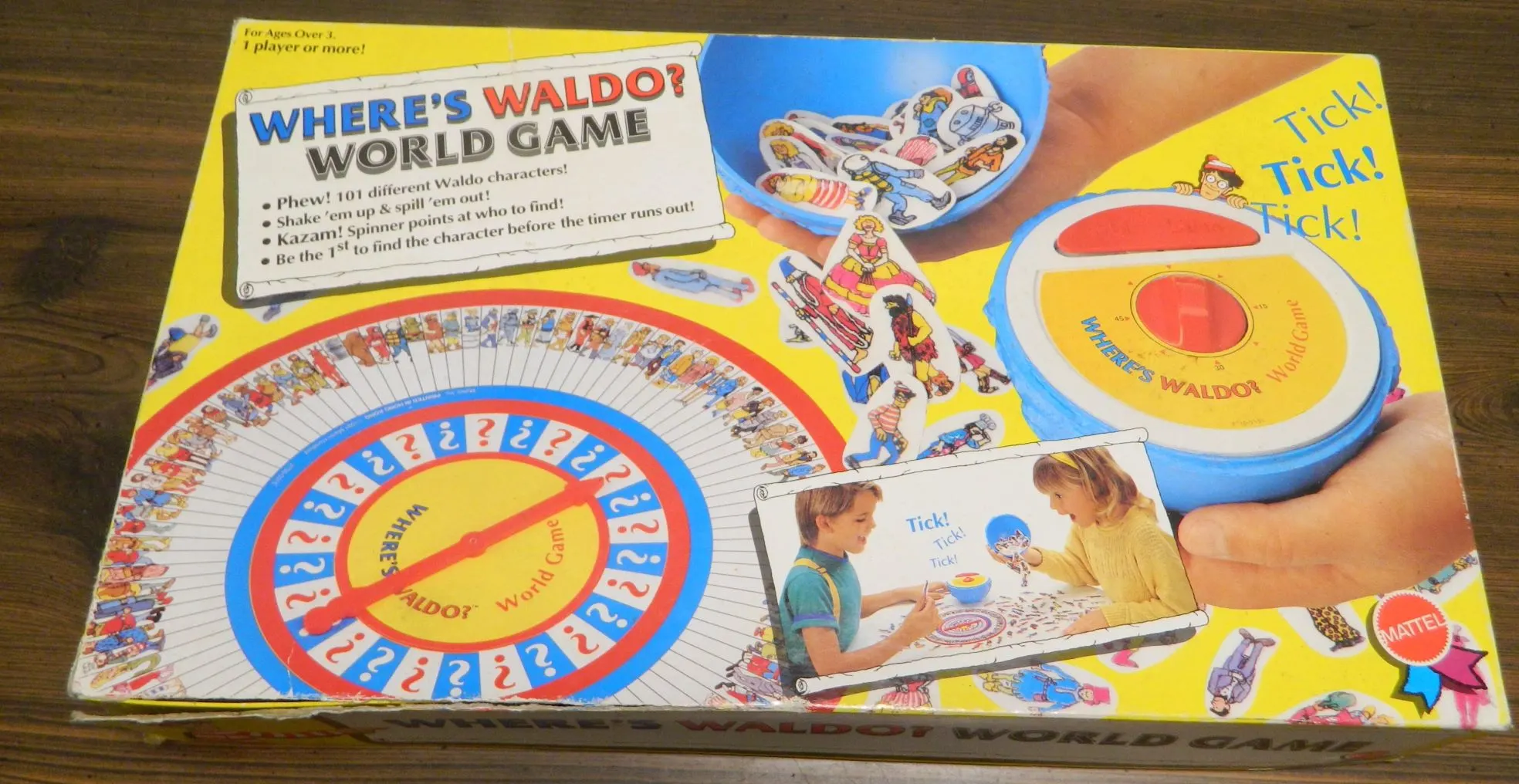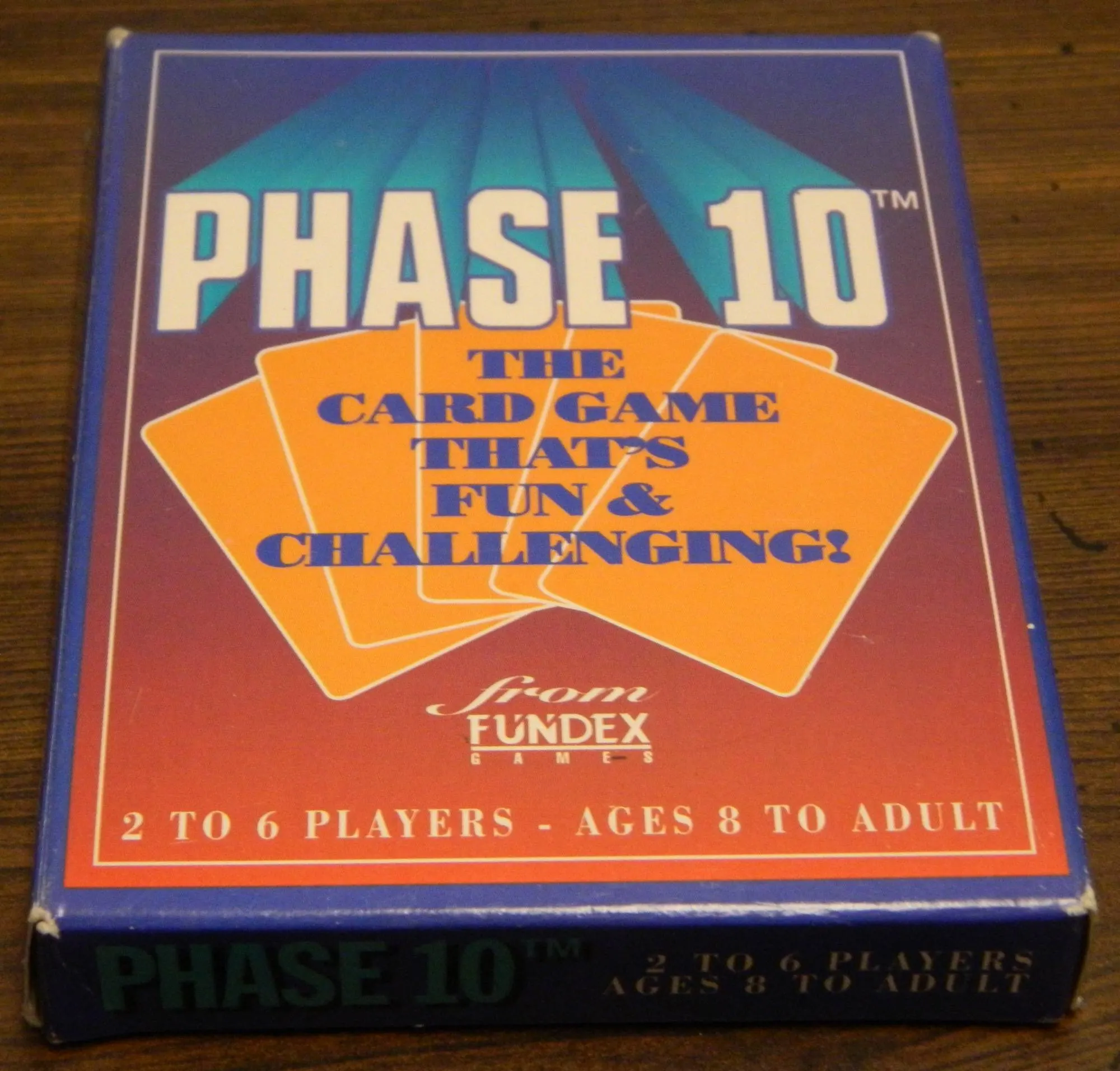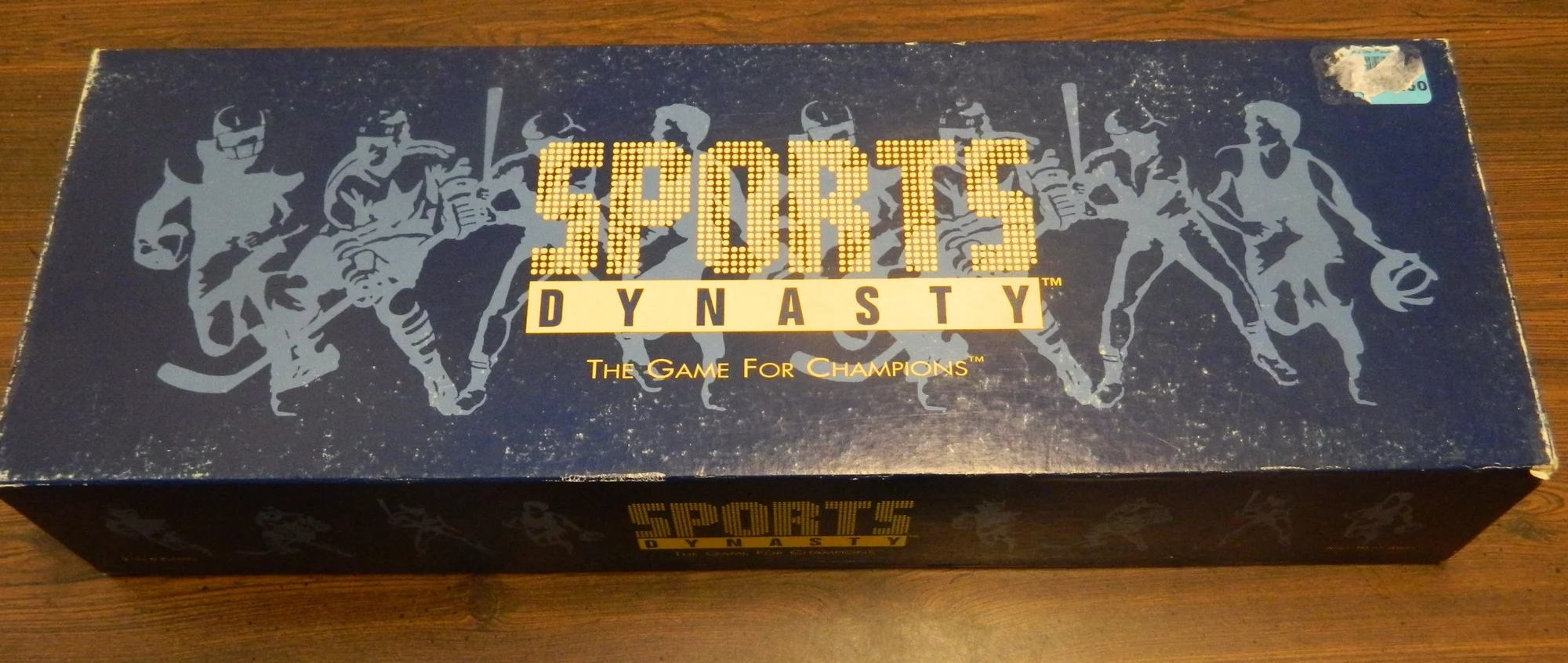Ever since I was a kid I have been a fan of UNO. I know that the game is flawed and yet there is something enjoyable about the game as you can play the game without putting too much thought into what you are doing. With how popular the original UNO was it wasn’t all that surprising that the game has had quite a few spinoff games made over the years. As a fan of UNO I have been trying to play through all of the different UNO spinoff games and have made it through quite a few of them at this point. So far I have had some mixed feelings about the spinoffs. Some are actually pretty good adding interesting new mechanics to the original game or applying the UNO theme to new gameplay experiences. Others have barely changed the original game and in some cases have made it worse. When I heard about UNO Rummy-Up I was intrigued. Unlike most UNO spinoff games UNO Rummy-Up is different from most UNO games as it mostly takes the UNO theme and applies it to a different genre of games. That genre is Rummy games and more specifically Rummikub. As Rummikub is a game that genuinely surprised me I was really excited to see how the UNO theme would apply to it. UNO Rummy-Up owes a lot to Rummikub as it is basically the same game with an UNO twist making it one of if not the best UNO spinoff game ever made.
How to Play UNO Rummy-Up
Setup
- To determine the first player all of the players will randomly draw one of the tiles. The player who picks the highest number will be the first player.
- Each player will take a rack and place it in front of them so the other players can see how many tiles they have remaining.
- All of the chosen tiles are returned to the rest of the tiles and all of the tiles are mixed up. These tiles will be placed face down in a pile on the table.
- Each player will draw 14 tiles and place them in their own rack.
- Randomly choose four more tiles and place them face up on the table. These will be the starting tiles that players can play off of.
Playing the Game
On a player’s turn they have a number of different options that they can take. One limit is that the players can only play between one to four tiles per turn. If a player is unable to play one of their tiles they will be forced to draw a tile. If this new tile is playable it can be played immediately. Otherwise it will be added to the player’s rack.
In UNO Rummy-Up players are trying to form different groups of tiles on the table. These groups must consist of at least three tiles. The two types of groups are runs and sets.
- Runs are a set of tiles in numerical order all of the same color. For example the two, three, four and five of green would be considered a run.
- Sets are a group of tiles of the same number, but in different colors. For example a five tile in yellow, blue, and green is a set. As there are only four colors the maximum size of a set is four.
Players can create sets and runs in a number of different ways. First a player can use the tiles from their rack to form a run or set. In order to form a new run or set you must play at least three tiles together that follow the above rules. Players can also play tiles from their rack along with tiles already played to the table. All of the tiles on the table can be used by all of the players. All runs and sets that are formed have to consist of at least three tiles.
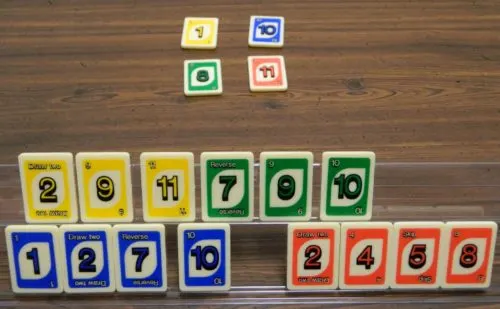
Here are the tiles that one of the players have in their rack. One potential play this player can make is to take the green Reverse/seven, nine, and ten from their rack and add them to the green eight on the table to create a 7-10 run.
One of the key mechanics in UNO Rummy-Up is that you can rearrange any of the tiles already played to the table. All tiles must stay on the table and none can ever be added to a player’s rack. Tiles can be moved in any way as long as each remaining run and set is still valid and contains at least three tiles. Using this rule you can break up larger sets and runs, combine two runs together to make a larger run, or dismantle a set or run and use each tile in another run or set.
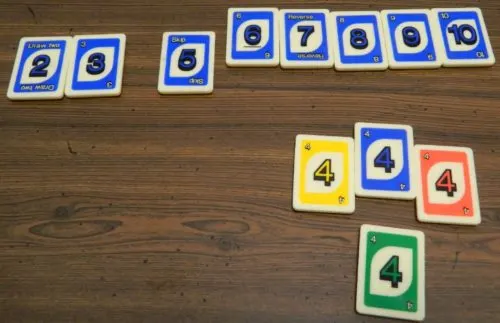
At the beginning of this player’s turn there was a 6-10 blue run on the table and a four set featuring a yellow, blue, and red four. This player begins their turn adding a green four from their hand to the set of fours. This allows them to take the blue four as there are still three fours left in the set. The player then adds a blue skip five to the blue run. The player will then add the blue four they took from the four set. The player will finally add a blue three and blue Draw Two tile to the run. This move allowed the player to get rid of four tiles from their hand (green four; blue Draw Two, three, and five/Skip). As the player played a Draw Two the next player will also have to draw two tiles and skip their next turn.
Special Tiles
Like every UNO game there are a number of special tiles in UNO Rummy-Up. Each of these special tiles has a special effect on the game. The key is that a tile’s power only applies when it is first played to the table. If a player plays two or more special tiles on the same turn they can only activate one of the played tiles. When a special tile is moved around on the table its’ special ability is not reactivated. If a special tile is one of the starting tiles its effect is ignored.
Wild Draw Four: When this tile is drawn the next player will have to draw four tiles and will miss their next turn. A Wild Draw Four can be played in place of any other tile in a run or set.
Only one Wild Draw Four can be in each set. A run can contain multiple Wild Draw Four tiles but they cannot represent two consecutive numbers in the run.

As there is a tile separating the two Wild Draw Fours this is a valid play. If the two Wild Draw Fours were right next to one another this would not be allowed.
Once a Wild Draw Four has been played other players can play the tile that the Wild Draw Four is acting as in the run/set and take out the Wild Draw Four. They can then use the tile as a wild in another run or set. Making this move does not force the next player to draw four cards and lose their turn though.
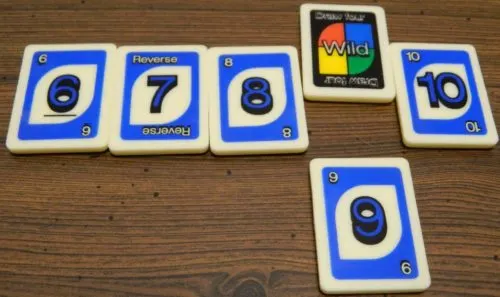
On a previous turn a player used a Wild Draw Four as a wild in this run. On this turn the current player has a blue nine. They can replace the Wild Draw Four tile with the blue nine and then use the wild with other tiles.
Draw Two (#2): A Draw Two tile will force the next player to draw two tiles and lose their next turn when it is first played. In runs and sets the Draw Two will act as a two.
Skip (#5): When a Skip tile is first played the next player will skip their turn. In the game all Skip tiles will also act as fives.
Reverse (#7): A Reverse tile will reverse the current order of play. For example if play is currently moving clockwise it will now move counter-clockwise and vice versa. Reverse tiles will act as sevens in the game.
End of Round/Game
When a player only has one tile left they must call out “UNO”. If someone catches them not saying UNO before the next player takes their turn they must draw two tiles. A player cannot be caught not saying UNO until their turn is over. If a player plays their last two, three or four tiles on their turn they will win the round without having to say UNO.

This player has one tile left in their rack. They must say UNO at the end of their turn before another player catches them.
The current round ends when one player has played all of their tiles. In the rare instance that all of the tiles have been drawn and no one has played all of their tiles the round will end. The player with the lowest count in their rack (I would assume this is number of tiles but the rules don’t specifically state this) wins the round.
The players who still have tiles in their racks will reveal them and the player who won the round will score points for each of the tiles. The number of points they will score is as follows:
- Normal Tiles: Points equal to their numerical value
- Draw Two, Reverse, Skip: 20 points
- Wild Draw Four: 50 points
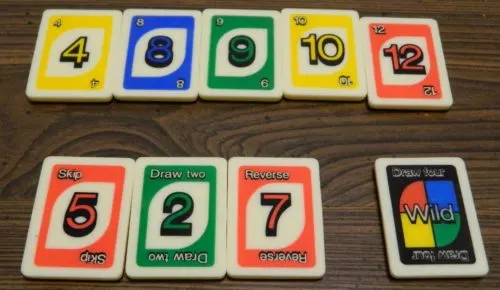
These are the tiles left in the other players’ racks at the end of the round. The winner of the round will score points as follows. They will score 43 points from the number tiles. The Skip, Draw Two, and Reverse tiles are each worth 20 points for a total of 60 points. Finally the Wild Draw Four is worth 50 points. In total the tiles will score 153 points.
If a player hasn’t scored a total of 200 or more points another round will be played. The first player to score 200 or more points wins the game.
Alternative Scoring
Instead of scoring points for the tiles remaining in a player’s rack the players can agree to ignore the traditional scoring. Players can agree to play a number of rounds with the player winning the most rounds winning the game.
My Thoughts on UNO Rummy-Up
With the name of UNO Rummy-Up you should have a good idea of what to expect of the game. Basically the game is what you would get if you combined the gameplay of Rummikub with UNO as the title aptly points out. Of the two games UNO Rummy-Up is more Rummikub with an UNO theme applied to it. Outside of a couple minor gameplay tweaks the gameplay in UNO Rummy-Up is exactly the same as Rummikub. The goal of the game is to get rid of all of your tiles by playing them into runs and sets. This includes being able to move around and utilize the tiles already played to the table.
As I have already reviewed Rummikub a while back I am not going to go deep into the main gameplay of UNO Rummy-Up as it will just be a rehash of the Rummikub review. Needless to say Rummikub is a good/great game. As a game that you regularly find in rummage sales and thrift stores Rummikub is honestly one of the best that you can find regularly for cheap prices. I think the game succeeds for a couple of reasons. First the game is pretty easy to play. The goal is to get rid of the tiles from your rack by playing them into groups that are either the same number in different colors or are numbers in consecutive order that are the same color. This is really simple where you can teach new players within minutes and almost everyone can easily play the game. You may need a round or two for players to fully understand, but players shouldn’t have too many issues with the game.
The game has some luck to it as the tiles you draw are going to have an impact on the game. Draw tiles that work well with the other tiles in your rack or with the tiles already played and you have a better chance of winning the game. At first it might not seem like the game has a lot of strategy/skill, but it has more than you would think. This is mostly due to the ability to manipulate the tiles already on the table. Generally it is pretty obvious how to play the tiles in your rack to create runs and sets. The real skill comes from figuring out how to manipulate the tiles that have already been played to increase the number of tiles you can play on a turn. Some moves are pretty obvious, but a player who is really good at the game can find creative uses of the tiles which opens up considerably more play opportunities. There is a surprising amount of strategy to Rummikub where it feels like the perfect balance between strategy and simplicity.
As UNO Rummy-Up basically takes these mechanics straight from Rummikub they apply to UNO Rummy-Up as well. The game is quite easy to play as it can be explained in a couple minutes. The additional mechanics in UNO Rummy-Up don’t drastically change the gameplay where they could probably be taught in just a couple minutes to people familiar with Rummikub. If you are familiar with both games you can probably learn the entire game within a minute or two. The strategy holds up as well as the key to doing well in the game involves figuring out the best way to use your tiles. Manipulating the tiles that have already been played is especially important to the strategy. Someone familiar with Rummikub should be able to jump right into playing UNO Rummy-Up.
Since the gameplay is basically taken from Rummikub, where does UNO come into play? UNO is used mainly in two ways. First UNO is used for the game’s theme. All of the tiles in the game are styled similar to the cards from your typical UNO game. In fact the tiles kind of look like mini cards. For the most part I actually think the game’s components are pretty good. The tiles look nice and are quite durable. The plastic racks are not bad and it was smart to make them clear so players can see how many tiles the other players have left. My main complaint with the components is that the outer box is way too large. The box could have easily been cut in half and the pieces still would have fit. This may be a turnoff for people who are more space conscious.
The main element of UNO in the game though is the addition of your traditional special cards found in almost every UNO game. The game includes four of the special cards that are found to some degree in every UNO game. These tiles are the Wild Draw Four, Draw Two, Reverse, and Skip cards. Anyone familiar with UNO should already know how all of these work as they work the same as the cards from any other UNO game. The one twist is that Draw Two, Reverse, and Skip cards also have a number associated with them which they also act as. Otherwise the special effects of each tile only impact the game once.
My opinion of the addition of these special tiles is kind of mixed. I can see some people really liking them and others hating them. I personally am somewhere in the middle. These special tiles mostly add more luck to the game as the players that draw them will get an advantage over the other players. They don’t drastically change the gameplay as they aren’t played a lot and each tile can only impact each round once. Occasionally players will have to draw tiles or miss their turn. These could make the difference between winning or losing a round. On the positive side these keep the game interesting as things can change pretty quickly. If you like these cards in UNO I don’t see why you wouldn’t like them in UNO Rummy-Up. People who don’t like the randomness they add though probably won’t like them. The good news is that you can totally ignore them if you want to. The special tiles can just be used where you don’t skip players or force players to draw tiles. The distributions of the tiles are almost the same. UNO Rummy-Up ends up having two more wild tiles and each color only goes up to twelve instead of thirteen like Rummikub does.
Other than the addition of the new tiles there are a couple other differences between the two games. The first new addition to UNO Rummy-Up is the addition of the rule that you are limited to only playing four tiles each turn. I am guessing this rule was mostly added in order to maintain the mechanic of having to say “UNO”. If players could play five or more tiles on a turn it kind of takes this mechanic away as you could quickly get rid of all of your tiles. I personally don’t really like the rule though. I think you should be able to play as many tiles as you want. You could have an epic play set up and not be able to complete it because it requires you to play more than four of your tiles. This takes away a little of the strategy from the game as you aren’t able to manipulate the tiles in the middle of the table as much as may want to.
On the other hand I do like that it got rid of the rule that you have to play a certain value of tiles in one round before being able to place tiles to the table. I have never really liked this rule in Rummikub as it makes rounds start too slow and it adds some luck to the game. If you don’t get tiles that work well together at the beginning of the round you will likely fall behind the other players. Some players may have to just sit around for a couple rounds until they get enough tiles that work together. This rule is not present in UNO Rummy-Up as you can start playing tiles immediately. The only restriction is that you need to play enough tiles that the runs/sets have at least three tiles. I think this was the right decision for the game as I never liked the rule in Rummikub.
The scoring between the two games is pretty similar. In both games points are scored for tiles left in players’ racks. In Rummikub players lose points for the tiles in their rack and the winner receives points for the other players’ tiles. In UNO Rummy-Up the winner only receives the points. The values of the tiles are similar between the two games except that UNO Rummy-Up has more unique tiles that are worth more points. In Rummikub the players play a certain number of rounds and then compare scores. In UNO Rummy-Up players play up to 200 points. I am not sure which scoring system is better. As for UNO Rummy-Up 200 points sound like a lot and each round can take quite a bit of time. It is possible to score enough points in one round though to win the game which happened to us in one game. The 200 points are not a firm rule as well as you can increase or decrease the number of points in order to shorten or lengthen the game.
So which game is ultimately better? I am not entirely sure. Some people will prefer UNO Rummy-Up while others will prefer Rummikub. I personally would probably say that Rummikub is slightly better as it relies on a little less luck. Those that prefer a little more randomness though will probably prefer UNO Rummy-Up as the addition of the special tiles brings some variety to the game. I personally think both games are good and outside of space I see no reason not to have both games. I will probably play Rummikub more, but I plan on playing UNO Rummy-Up every so often as it has a unique twist on the gameplay.
Should You Buy UNO Rummy-Up?
Despite using UNO more for its theme than its gameplay, I honestly think UNO Rummy-Up is arguably the best UNO spinoff game. You can even make a good argument that it is better than the original game. UNO Rummy-Up is basically what you would get if you combined UNO with the classic game of Rummikub. The main gameplay is exactly the same as Rummikub as you use the tiles in your rack as well as the tiles that have already been played to create runs and sets. Like Rummikub this is pretty easy to learn and yet has quite a bit of strategy as you need to do a good job manipulating the tiles on the table. The main difference between the two games is the addition of special tiles which should be familiar to fans of UNO. These work just like they do in the card game. They add some variety to the game and keep things interesting despite also adding some luck. Otherwise there are a couple other minor differences that don’t drastically impact the gameplay.
My recommendation for UNO Rummy-Up actually has more to do with your opinion of Rummikub than UNO. If you have never liked Rummikub or other similar Rummy games I don’t see you liking UNO Rummy-Up. Fans of Rummikub though should enjoy UNO Rummy-Up. Whether you will prefer it over Rummikub will ultimately depend on whether you think you will like the addition of the special tiles. For those of you who have never played Rummikub before I would say that you should check out either Rummikub or UNO Rummy-Up if the game’s premise sounds interesting as they are both fun games.

